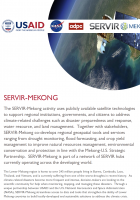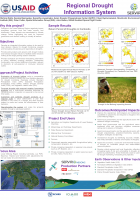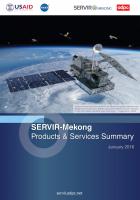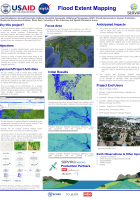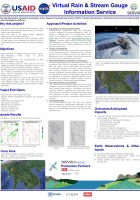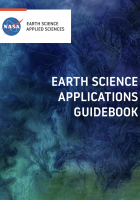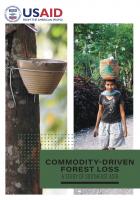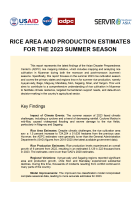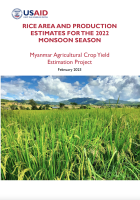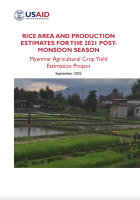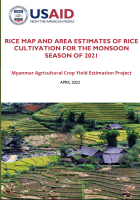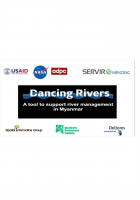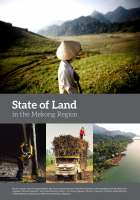Brochures, Fact Sheets and Posters
SERVIR-MEKONG
The SERVIR-Mekong activity uses publicly available satellite technologies to support regional institutions, governments, and citizens to address climate-related challenges such as…
Implemented by the Asian Disaster Preparedness Center (ADPC), SERVIR-Mekong is funded by USAID in partnership with NASA. This infographic card provides an overview of the program.
Why this Project?
Droughts in the Lower Mekong Region negatively impact ecosystem services, food and water security and biodiversity. These impacts are exacerbated by climate change, further…
SERVIR-Mekong is a USAID-NASA partnership program designed to improve environmental management and resilience to climate change in the Lower Mekong Region through the increased application of…
Language:
SERVIR-Mekong is a USAID-NASA partnership program designed to improve environmental management and resilience to climate change in the Lower Mekong Region through the increased application of…
Why this Project?
The Lower Mekong Basin is subject to extremes in streamflow conditions, including frequent flooding during the annual monsoon. Understanding and chronicling historic and current…
Monitoring land cover and land use change is important for land resource mapping, understanding ecosystem services including resilience to climate change, biodiversity conservation and other issues.…
Rain and stream gauge data are sparse in time and space, which hampers decision making on long term planning and development. In addition, river flow data is not widely shared, especially…
Knowledge Products
The Earth Science Applications Guidebook is a web-based, multimedia product that synthesizes best practices and lessons learned on the use of Earth science information for decision-making. It is also…
Commodity-Driven Forest Loss: A Study of Southeast Asia represents the culmination of a nearly two-year study funded by the U.S. Agency for International Development’s Regional Development Mission…
Pagination
Cambodia
“Impressions” chronicles SERVIR-Mekong's journey from its launch until the present day. The book documents the program's achievements and learnings as SERVIR-Mekong looks to the future—using…
Laos
“Impressions” chronicles SERVIR-Mekong's journey from its launch until the present day. The book documents the program's achievements and learnings as SERVIR-Mekong looks to the future—using…
Myanmar
This report represents the latest findings of the Asian Disaster Preparedness Center's (ADPC) rice mapping initiative, which includes mapping and analyzing rice cultivation in Myanmar during both the…
This report provides an in-depth analysis of unbiased rice area estimations for the major monsoon rice-producing regions of Ayeyarwady, Bago, Kayah, Kayin, Magway, Mandalay, Mon, Rakhine, Sagaing,…
“Impressions” chronicles SERVIR-Mekong's journey from its launch until the present day. The book documents the program's achievements and learnings as SERVIR-Mekong looks to the future—using…
The study analyzes rice cultivation in Myanmar for the 2021 post-monsoon season, covering eight of the country's most significant rice-producing regions. The research provides a comprehensive…
This study focuses on monsoon rice cultivation in Myanmar across the nine most important rice producing regions including Sagaing, Bago, Magway, Mandalay, Yangon, Ayeyarwady region, and Mon, Rakhine…
In Myanmar, changes in river morphology including floods, erosion, and landslides are affecting ecosystem habitats and the lives and livelihoods of communities living along rivers. SERVIR-Mekong is…
Regional
“Impressions” chronicles SERVIR-Mekong's journey from its launch until the present day. The book documents the program's achievements and learnings as SERVIR-Mekong looks to the future—using…
The Earth Science Applications Guidebook is a web-based, multimedia product that synthesizes best practices and lessons learned on the use of Earth science information for decision-making. It is also…
Pagination
This report represents the latest findings of the Asian Disaster Preparedness Center's (ADPC) rice mapping initiative, which includes mapping and analyzing rice cultivation in Myanmar during both the…
This report provides an in-depth analysis of unbiased rice area estimations for the major monsoon rice-producing regions of Ayeyarwady, Bago, Kayah, Kayin, Magway, Mandalay, Mon, Rakhine, Sagaing,…
“Impressions” chronicles SERVIR-Mekong's journey from its launch until the present day. The book documents the program's achievements and learnings as SERVIR-Mekong looks to the future—using…
The study analyzes rice cultivation in Myanmar for the 2021 post-monsoon season, covering eight of the country's most significant rice-producing regions. The research provides a comprehensive…
This study focuses on monsoon rice cultivation in Myanmar across the nine most important rice producing regions including Sagaing, Bago, Magway, Mandalay, Yangon, Ayeyarwady region, and Mon, Rakhine…
The Earth Science Applications Guidebook is a web-based, multimedia product that synthesizes best practices and lessons learned on the use of Earth science information for decision-making. It is also…
Commodity-Driven Forest Loss: A Study of Southeast Asia represents the culmination of a nearly two-year study funded by the U.S. Agency for International Development’s Regional Development Mission…
In Myanmar, changes in river morphology including floods, erosion, and landslides are affecting ecosystem habitats and the lives and livelihoods of communities living along rivers. SERVIR-Mekong is…
The Mekong region is in the midst of profound social and environmental change. Despite urbanization, the region remains predominantly rural with more than 60 percent of its population living in rural…




